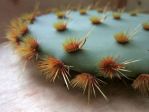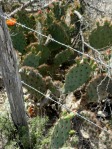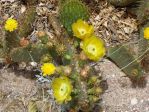
Griffiths, Proceedings of the Biological Society of Washington 29(3): 10, 1916
Lectotype; Isolectotype; Herbarium; Herbarium; Herbarium; Color Plate (Britton and Rose, v1 1919, plate XXVIII)
Original Citation
What is Opuntia acicualta?
Opuntia aciculata is a medium-sized prickly pear cactus that is generally spineless but with copious glochids. It is distinct from O. engelmannii, O. lindheimeri, or O. strigil though it has been confused with those opuntias.
O. aciculata is tetraploid.
Details
These prickly pears may reach 1 m tall and spread to 2 m across and form hemispherical mounds, but they are often smaller. The main branches of this Opuntia may ascend or may rest on edge with secondary branches rising from them. Cladodes may be 15 by 20 cm and obovate to ovate, sometimes they turn pinkish in very cold weather. Areoles are about 5 mm in diameter. Often areoles are spineless. Sometimes areoles have 1(2) small spines that slope down. Glochids are numerous and prominent and may be 0.5-1(2) cm long, and they are arranged uniformly around the areoles in a distinctive, dense, bristly ring. The prominent glochids are as dangerous as they are attractive.
This Opuntia has red, orange, or yellow flowers, but yellow flowers with or without a greenish center are by far the most common. The filaments are yellow or pale-yellow and the stigma is dull-green. The flowers are about 9 cm in diameter. The fruit is obovate to pyriform and often has a conspicuous bloom. The outer surface of the fruit is light purplish red.
O. aciculata is tetraploid.
Other Notes
Britton and Rose reported that the plant is found in scattered small colonies near Laredo, Texas where it is “not very common”. It is often found on dry hills in colonies. The plant is found sporadically in Mexico too. A spiny form of this Opuntia was invalidly named O. strigil flexospina, but such is really just a minor spine variant of O. aciculata.
This prickly pear is encountered in southwestern gardens because of its attractive flowers and cladodes. A red-flowered form is especially attractive. It is not a plant to grow close to busy sidewalks. It is semi-hardy in Albuquerque, NM, being frozen to the ground in the coldest winters.
For more information, see:
Newland K.C. and Crosswhite, F.S. (1985) Cacti in the Living Plant Collection of the Boyce Thompson Southwestern Arboretum. Desert Plants. 7. University of Arizona.


















I love Opuntias ! I’d like to collect one of each species if I had the land